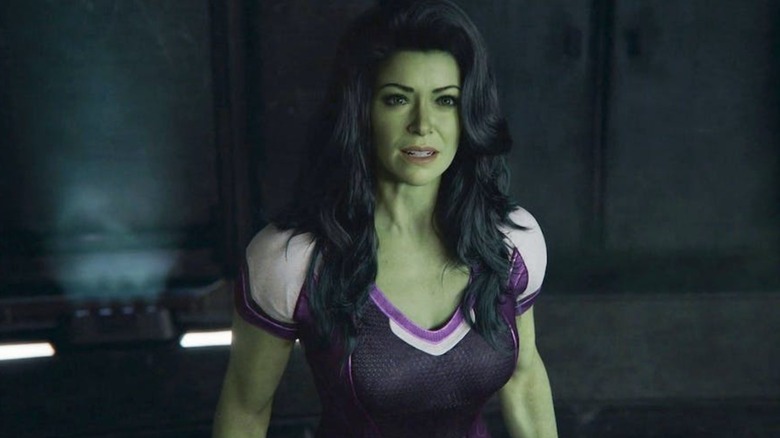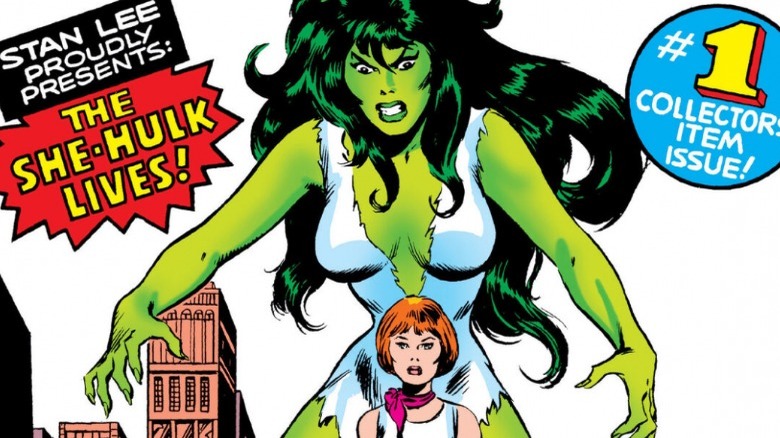Stan Lee Created She-Hulk Out Of A Legal Fear From Lou Ferrigno's The Incredible Hulk
Long ago, before the Marvel Cinematic Universe's gargantuan interconnecting list of films and Disney+ shows, there existed Universal Television's "The Incredible Hulk" series. Although it seems quaint in comparison to today's mega-budget superhero fare, Kenneth Johnson's science-fiction drama hybrid was a major ratings hit and was one of the earliest success stories regarding a live-action comic book adaptation. The popularity of the series, as well as the strange legal tension between Marvel Comics and its licensing partners, is why Stan Lee rushed to create a She-Hulk before Johnson could.
In the '70s, Marvel Comics had sold the rights to a handful of its characters to the separate company of Universal Television. Besides the Hulk, Ms. Marvel, Namor, and the Human Torch were also on the studio's bracket. Johnson, who had already found success with Universal's "The Bionic Woman," initially wasn't interested in adapting any of these due to his disinterest in superhero comics. However, he realized he could interpret the Hulk with his own sensibilities in mind, and he decided to move forward. Johnson's vision for "The Incredible Hulk" was supposed to be more realistic than the character's comic book origins; "a little bit of Victor Hugo, a little bit of Robert Louis Stevenson's 'Jekyll and Hyde'," as he described it. Johnson was allowed control over casting, and the dual leads of Bill Bixby as Dr. David (not Bruce) Banner and Lou Ferrigno as the Hulk helped make the show a mean, green ratings machine.
"The Incredible Hulk" brought the Jade Giant into the mainstream consciousness, yet Lee ironically saw its existence as a threat to Hulk's comic book legacy. Sensing Johnson would repeat the formula he applied to "The Bionic Woman" (itself a woman-led spin-off of "The Six Million Dollar Man"), Lee created a female counterpart to the Hulk.
To she or not to She-Hulk
The first issue of "The Savage She-Hulk," the debut appearance of Bruce Banner's cousin Jennifer Walters, was the only one in the series written by Stan Lee. The rest of the run was penned by David Anthony Kraft, who lamented the character as a rush job. Sean Howe's book "Marvel Comics: The Untold Story" quotes Kraft as saying She-Hulk was "done under duress." Kraft explained:
"It was like, 'We need to create a character called the She-Hulk and we need to get it out in the next 30 seconds.' If you look at that first issue that Stan did, there's really nothing to it: Bruce Banner gives a blood transfusion to his cousin, she growls and runs around, and that's basically it. I grew up on Marvel Comics, and remembered Stan making fun of how DC had endless iterations of the characters: Super-Monkey, Super-Horse and Streaky the Super-Cat and on and on. We were all pulling our hair out and wailing and bemoaning the day that Marvel had to create a She-Hulk."
Thankfully, Jen Walters has grown to become much more than just a gender-swapped copycat of her cousin, thanks to the meta elements of John Byrne's "Sensational She-Hulk" and the zaniness of Dan Slott's "She-Hulk," both of which were the main inspirations for the MCU's live-action "She-Hulk: Attorney at Law" series on Disney+. Besides, Stan Lee turned out to be right: Kenneth Johnson admitted that the plan for the cancelled fifth season of "The Incredible Hulk" was for David Banner to save his dying sister's life with a blood transfusion, turning her into, you guessed it, a She-Hulk.

